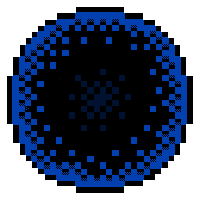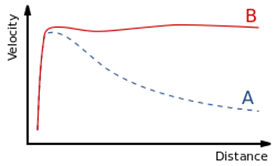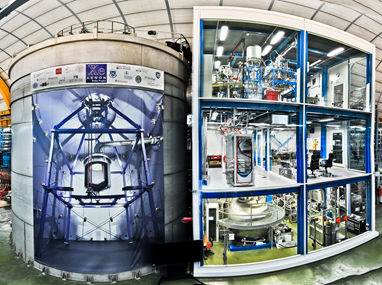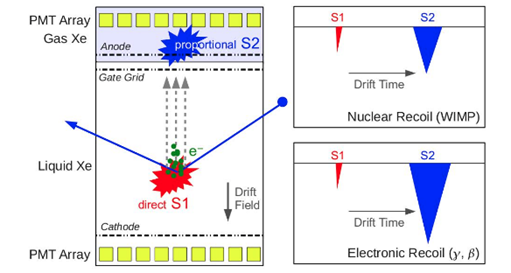
Our current knowledge covers only about 15% of the matter in the Universe. The remaining 85% is dark matter, of which we know virtually nothing.
Dark matter is a hypothetical type of matter different from ordinary matter, such as protons, neutrons and electrons. To study it one can use a scintillator, a material, which emits a faint light when a particle passes through it. Scintillators haves to be ultra-pure to reduce at minimum the ‘’noise’’ of their intrinsic background in order to be able to detect the rare interactions with the dark matter.
La Dark Matter is a possible new kind of matter different from “ordinary” matter (protons, neutrons and electrons). We do not know what it is made of, however we know it accounts for about 85% of matter in the Universe (or 25% of energy balance) according to the Standard Cosmological Model. It is named Dark Matter because it neither emits nor reflects light, thus we can’t see it with our eyes. So far, we have several indirect evidences of its presence in measurements of gravitational effects which can be understood only if we assume that there is more matter than what we observe. For example, spiral galaxies show a rotational field velocity much higher than what is predicated by gravitational Newton law (Fig1). As we move further away from the rotational center the observed velocity should decrease, while we observe that it stays constant according to the distance. This can be explained assuming that the galaxies are immersed in a dense cloud (halo) of heavy particles feebly interacting with ordinary matter. The presence of this additional mass makes it possible that spiral galaxy clusters can stay together instead of flying away from each other, and also cause gravitational lensing phenomena where gravity affects the light path and so formation of images which often can be doubled. One possible explanation for such a weird phenomenon can be the presence of matter interacting gravitationally, which cannot be detected. The existence of Dark Matter can also explain key features of the Cosmic Microwave Background, which is a relic radiation formed 350000 years after the begin of the Universe.

Fig. 1. The curves in the image represent the rotational velocity of stars according to distance from galactic center, predicted (dashed line) and observed (full line).
Regardless the large number of indirect evidences of this matter we have not yet managed to detect it directly in any of our apparatuses. Direct evidence is fundamental to the understanding of the key properties of this type of matter. Many theoretical models, beyond the Standard Model of Subatomic particles, foresee the existence of very massive particles which exert a gravitational force and interact feebly with ordinary matter. Among various candidate particles the most known are called WIMP (Weakly Interacting Massive Particles) which could be present in the Universe as remnant particles from an era when it was much hotter and denser and many massive particles were contributing to the energy content of the Universe.
It is believed that the interaction between Dark Matter and ordinary matter is so weak that high sensitivity detectors are needed. The first key feature of such an apparatus is the capability to reject all spurious events (background) that can mimic the expected Dark Matter signal. To further improve the background rejection the detector must be installed in a site well protected from cosmic rays, which are made up of a continuous flux of particles reaching the Earth’s surface (See “Muon Veto”) . The LNGS offers a site where the cosmic rays are very much reduced (more than a factor 106) thanks to the 1400 m of overlying rock (Gran Sasso massif). At the LNGS (May 2019) there are six experiments dedicated to detecting Dark Matter: DAMA, SABRE, COSINUS, CRESST, DARKSIDE and XENON1T/XENONnT. DAMA and SABRE aim at measuring the annual modulation of Dark Matter interactions as expected by the variation of the Earth’s velocity with respect to the galactic halo during the year, the maximum is expected on June 2nd while the minimum happens on December 2nd. COSINUS studies dark matter using the same target material as DAMA and SABRE (NaI crystals) but with a different detection technology.

Fig.2 L'apparato sperimentale dell'esperimento XENON1T. A sinistra la grande tanica al cui centro è posta la camera a proiezione temporale, visibile sul cartellone. A destra della tanica i tre piani che costituiscono il laboratorio (Crediti immagine: XENON Collaboration)
This technology, used also by the CRESST experiment, is based on calorimetric measurements (phonons) in very low temperature (10-100 mK) crystals, which are controlled to depress the thermal noise and allow for detection of very low energy deposits by Dark Matter. DARKSIDE and XENON1T/XENONnT exploit a different technological approach which is described in the following section.
The XENON1T detector is currently the most sensitive experiment looking for Dark Matter in the form of WIMPs with masses in the range of 1-10000 GeV/c2. The first thing we see of our apparatus is a cylindrical tank which contains ultra- pure water instrumented with photomultipliers to detect the presence of possible residual cosmic rays reaching the underground site (Fig2). This is called muon-veto which hosts in the center the cryostat which contains the liquid xenon target (3300 kg) instrumented with a so called Time Projection Chamber (TPC). The TPC has a cylindrical shape, 1 m in height and 1 m in diameter, with an electrode at both ends, the anode and cathode, respectively. The two electrodes are able to generate an electric field (drift field) and thanks to the field shaper rings, installed all around the shell of the cylinder, the field is made as uniform as possible. Xenon is a good scintillator, meaning the capability to emit light in correspondence of energy released by particles. The light signals are detected by means of light detectors (248 photomultipliers) which convert light into a recordable electrical signal (See photomultiplier).The energy released, making xenon electrons or atoms recoil, also produce ionization charge, i.e. electrons stripped from surrounding atoms, which are drifted to the liquid-gaseous surface by the drift field, and subsequently extracted by a stronger electric field (>10 kV/cm) towards the gaseous phase where the electrons are further accelerated and a second light pulse is produced. This light is also detected by photomultipliers grouped in two arrays, top and bottom. This type of detector allows us to reconstruct the 3D position of the events. In fact, the time difference between the prompt and delayed light allows us to measure the vertical coordinate while the pattern of secondary light allows us to measure the transverse coordinates and all together this information makes the 3D reconstruction of the interaction vertex possible. The 3D reconstruction of interactions is crucial to distinguish between events happening on the outer surface of the instrumented volume, mainly due to background events, with respect to the events taking place in the core of the detector that can be reached only by WIMPs. Furthermore, by comparing the two light signals, described above, it is possible to distinguish between nuclear recoils (WIMP generated) and electron recoils mainly originated by spurious events (Fig. 3).

Fig. 3. Detection principle of the TPC. The two signals S1 (prompt) and S2 (delayed) are illustrated. The light detectors are represented by circles arrays (top and bottom). The time difference between S2 and S1 gives the measurements of the vertical coordinates. The light pattern on top array will give the transverse coordinates measurements
While the TPC is the sensitive device where Dark Matter interaction will be detected, the big tank serves as an absorber of environmental radioactivity and as a muon-veto (See muon veto). The reduction of undesired events is also achieved through a careful selection of components which have been previously screened to measure possible presence of traces of radioactive elements and thus sort out materials/components. For the same reason the xenon is continuously purified to remove the two main radioactive contaminants such as Kr and Rn (vedi sample tube) . We can proudly say that the XENON1T apparatus is the cleanest place in the world.

Discover the experiments and help the alien to get back home!
Play now